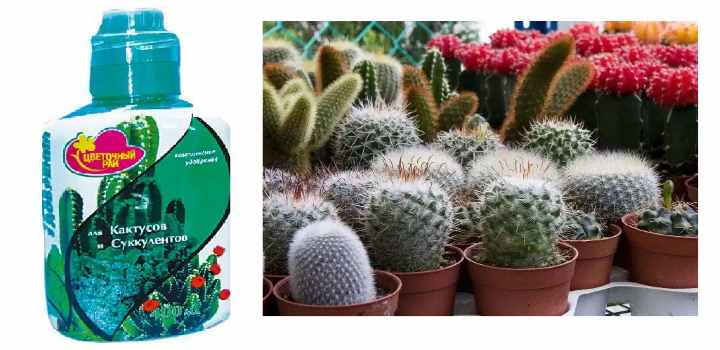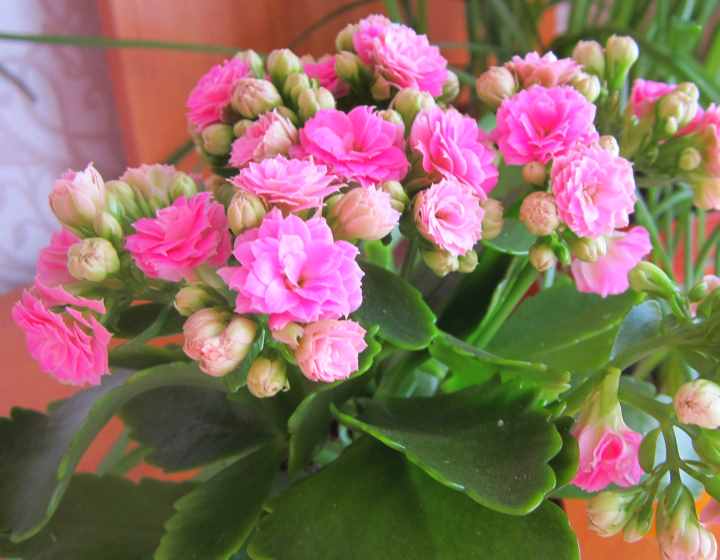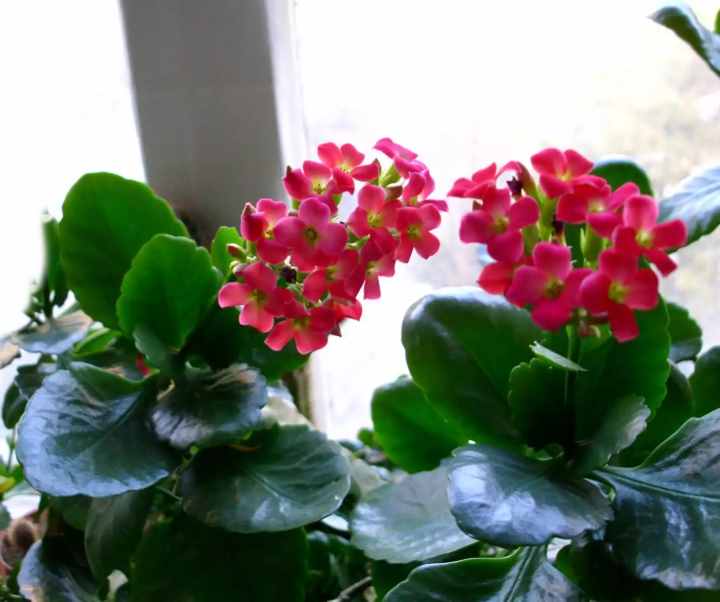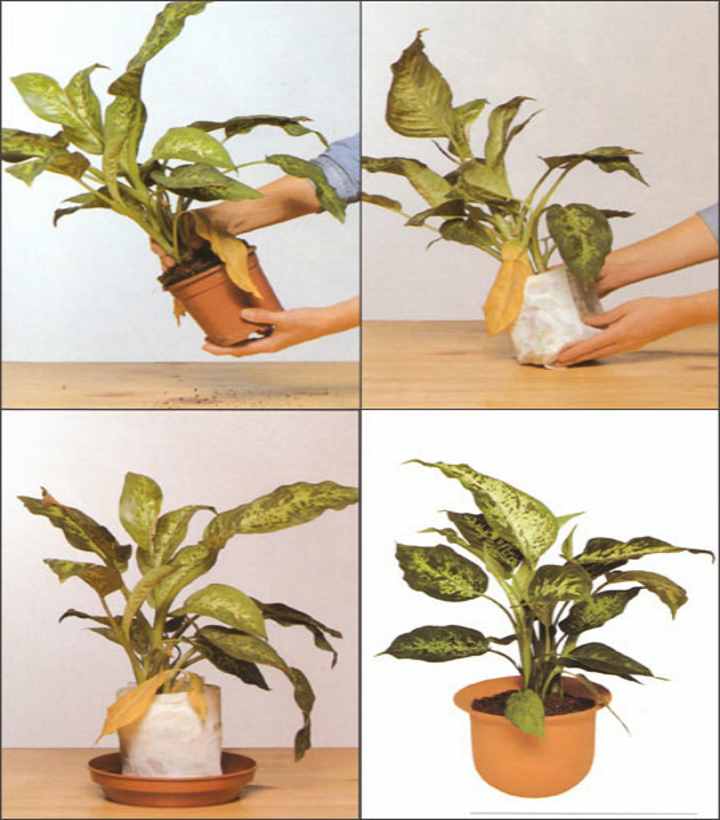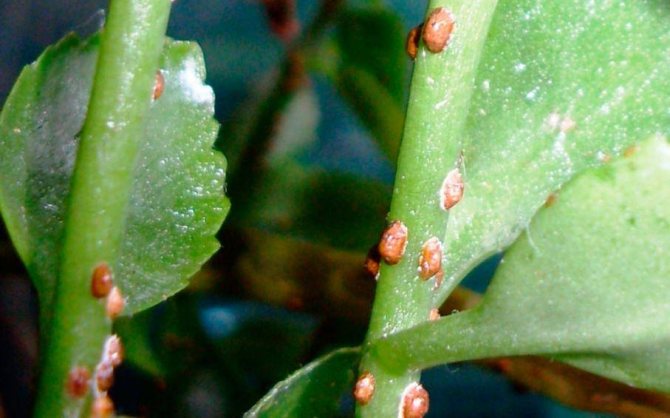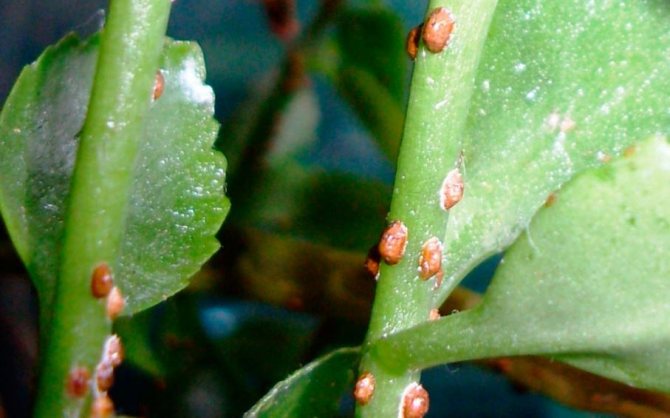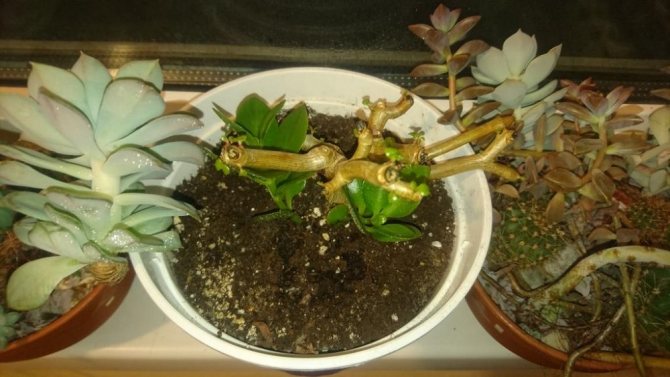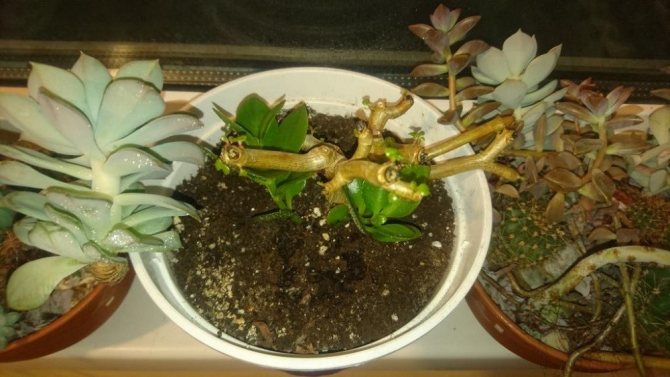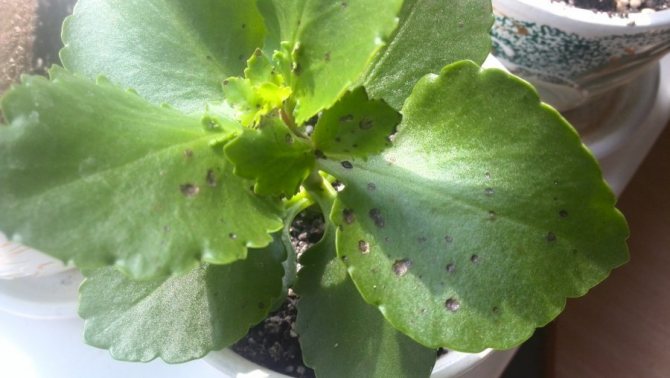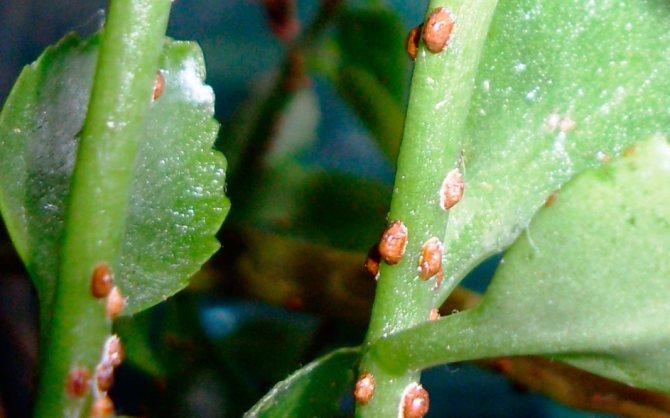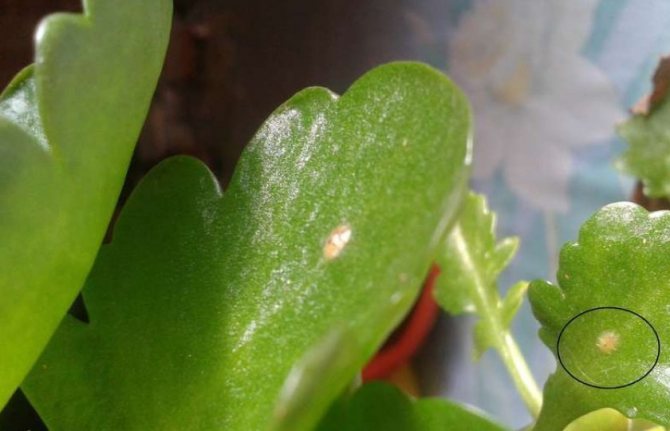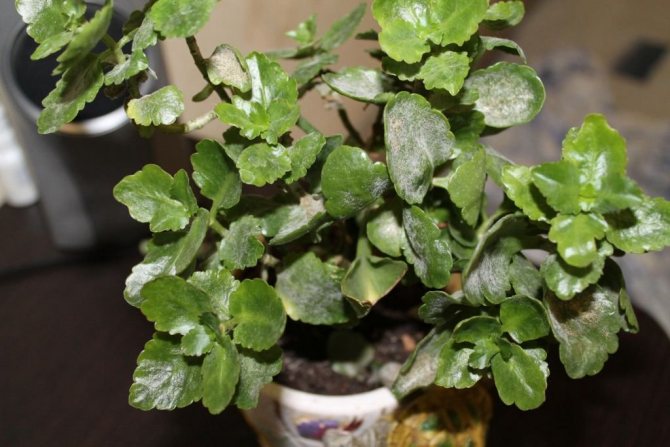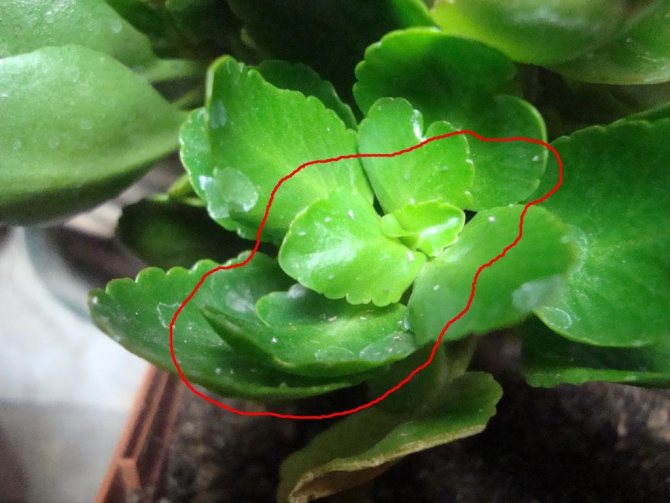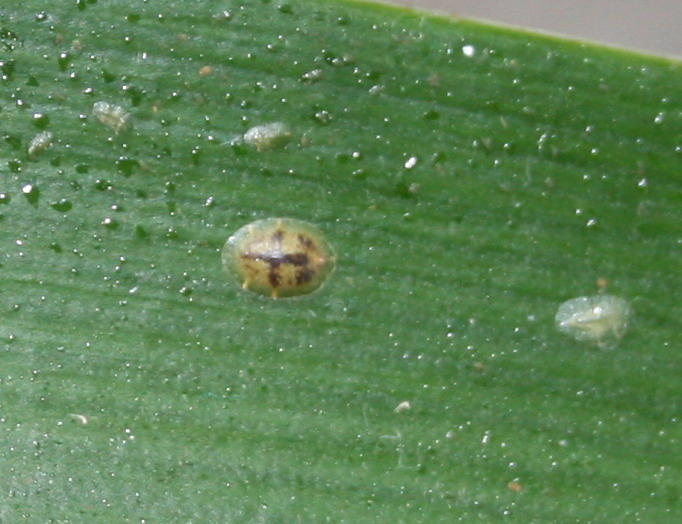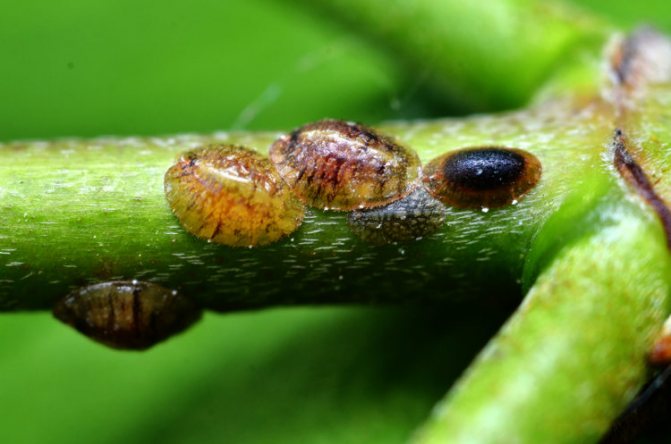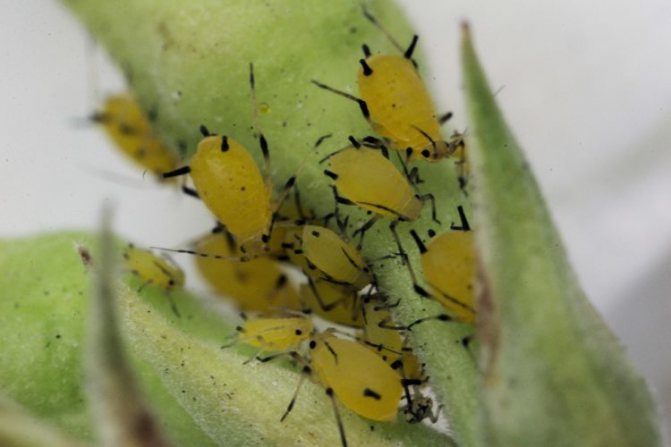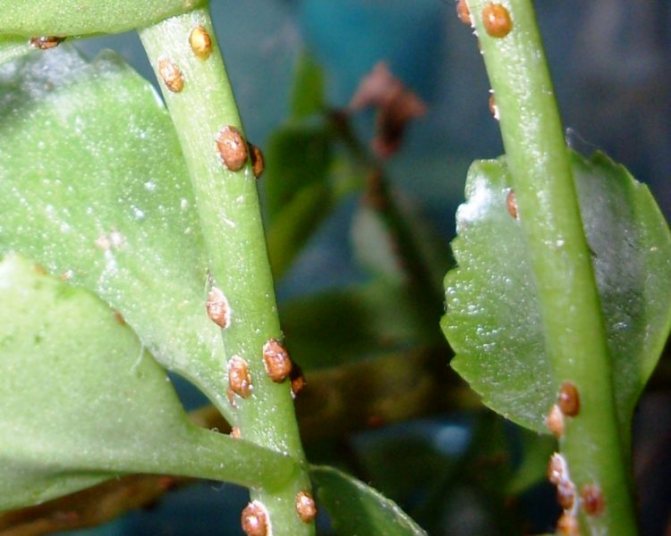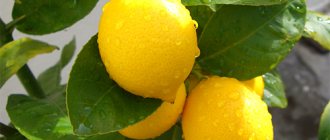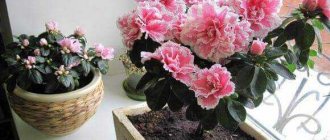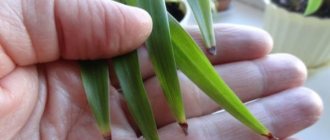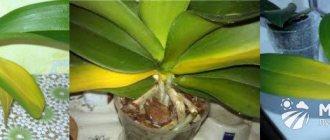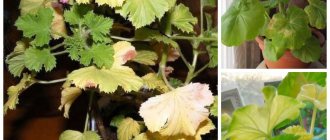
Kalanchoe is considered one of the most unpretentious indoor plants, but due to certain circumstances, even it is not immune from trouble. Diseases or mistakes in care can pretty much spoil the appearance of the flower and even ruin it. Today we want to tell you how to revive the Kalanchoe, depending on what happened to him.
So, most often with a blooming handsome man there are such problems:
- foliage dries and crumbles;
- leaves wither and lose turgor.
Why do the leaves wither
Sometimes a succulent flower takes on an unsightly appearance, its leaves begin to wither, they become soft in consistency. If the causes of this phenomenon are not eliminated, the foliage will fall off completely.
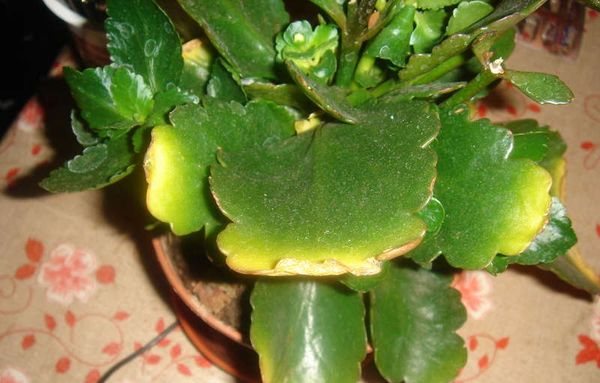

The following points lead to such a situation:
- excessive watering. Kalanchoe is able to retain water in its leaves. For this reason, a healthy flower looks dense. The foliage is crumbling - the plant is flooded;
- insufficient watering. This plant can be for some time without additional moisture, but with prolonged drought, the leaf withers and falls off;
- poor water performance. Only soft and settled water can be used for irrigation, otherwise diseases will appear, and the plant will begin to die;
- direct sunlight, which can scorch the leaves;
- improper temperature conditions can also cause the foliage to wither, dry out and fall off.
It is especially important to monitor compliance with these parameters in winter. During the dormant period, the Kalanchoe is especially sensitive, and even small fluctuations in the above parameters can lead to the plant beginning to disappear.
Prevention measures
To prevent diseases and pests from harming your Kalanchoe, follow the preventive measures:
- strictly limit watering in winter and at low indoor temperatures;
- inspect the leaves, especially on the back;
- monitor the concentration of nitrogen in the soil - it should be less than potassium and phosphorus;
- do not place the plant in direct sunlight;
- twice a year, you can carry out preventive treatment with fungicides and insecticides;
- any plant you bring home is best checked for pests and diseases.
Kalanchoe is a fairly hardy culture, but it can also be affected by insects and diseases. The main thing is to help the flower heal in time.
Why do the leaves turn yellow
Now let's figure out why the leaves of the Kalanchoe turn yellow. The plant can turn yellow for almost the same reasons that were described in the previous section. However, this negative phenomenon has its own nuances, and we will talk about them. If your indoor Kalanchoe leaves turn yellow, first of all, check the watering regime. The plant begins to turn yellow with an excess of light. This green space loves bright light, but no more than 10 hours a day.
There are two ways to create the right lighting:
- artificially create a short daylight hours, covering the flower with an opaque cloth;
- put on the east windowsill.
It is noteworthy that if the Kalanchoe is stretched out yellow, then it will not be possible to save the escape. Your green friend can also change color due to dry air. Hot radiators negatively affect this plant - the tips of the leaves begin to turn yellow.


Too high air temperature is another common cause. In general, the flower looks healthy, but the leaves are slightly shriveled, but not dry. Kalanchoe leaves turn yellow due to natural processes. If the lower leaves turn yellow, gradually dry up and fall off, then you should not worry.
Foliage may become discolored due to improper fertilization. At first, the leaf plates turn yellow, and then turn brown. Did you notice this on your Kalanchoe? Understand the top dressing. Various insects can also cause pigmentation of the leaf blade. And, finally, if you do not pay close attention to the Kalanchoe and start all of the above reasons, the plant will get sick. The leaves will turn yellow very quickly, the flower will begin to fade and will soon die.
Causes of drying and falling leaves


During the heating season, the tips of the leaves of the Kalanchoe often dry out. This is due to low air humidity, which the plant does not tolerate well. Keep the pot away from the radiator and fireplace.
If the leaves began to turn yellow and crumble, the bush does not have enough nutrition. From late spring to early autumn, it needs to be fed with mineral complexes for succulents. In this case, use a concentration 2 times lower than the recommended one.
The foliage also dries up from too bright lighting. In summer, the best place for Kalanchoe is the east window.
Why do leaves dry
If the castings of the Kalanchoe begin to dry intensively, it means that they need emergency help. You can save a green pet at home, but you need to recognize the reason. In general, Kalanchoe is unpretentious and does not require special care. Why, then, do the leaves dry on the flower? The reason that even with good care the leaf plate dries out, it may be an incorrect fit. When planting for a flower, it is imperative to place drainage in the pot in order to avoid rotting of the root system.
The soil may not be suitable. Kalanchoe does not like acidic soil. The plant should be placed in such a way that the sun's rays fall on it in moderation, avoiding direct contact. If the temperature is not suitable for the flower - it is cold or hot - then the leaf plate can also dry out. Watering should be moderate and depends on the condition of the soil.
Excess moisture also brings trouble to the flower. Drying of the leaves can be the result of illness or the fact that the Kalanchoe was visited by "uninvited guests". Of course, when the plant is old and its life cycle comes to an end, you can also observe the drying of the leaves.
How to reanimate Kalanchoe
To revive the Kalanchoe, be sure to remove all damaged leaves, spray with a modern insecticide or fungicide, depending on the reason.
If the plant is badly damaged, the lesion covers the stem, roots and most of the leaves, the only method of resuscitation is transplantation. For this, an apical or lateral stalk is used, the new soil is necessarily disinfected, it is advisable to use a sterile pot. Adjacent flowers are subject to processing.
Why do leaves fall
Having bought a flower, many owners who are just starting to engage in indoor floriculture are wondering why the Kalanchoe sheds its leaves. It happens that the lower leaves fall off. Most likely, the reason is a lack of sunlight.
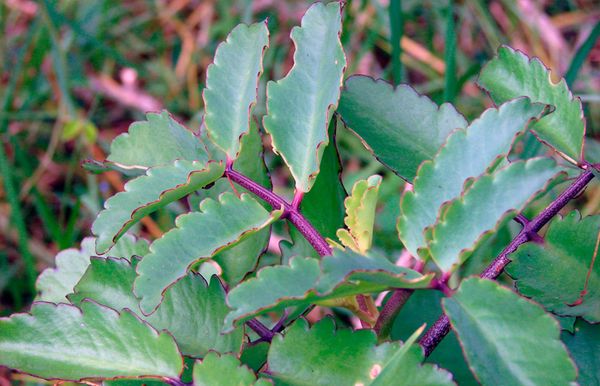

Sometimes a cramped pot will cause the flower to shed its leaves. Another reason may be parasites that have settled on a pet: aphids, scale insects. The scale insect not only "eats" the plant, but also injects its poison. As a result, the leaves may turn black. The flower can throw off the leaves, and this indicates the beginning of the aging process. If the green space is close to the heating system, then the leaves may fall off, since the optimum temperature for a flower is + 15 ° C.
If Kalanchoe leaves constantly fall, despite all your efforts, then transplant the “kids” into a new pot, and you will have to say goodbye to the old plant.
The main diseases and methods of control
Leaf diseases are the first thing to look out for. The foliage of the flower is soft, juicy, so any disease is visible on it at an early stage. It is also necessary to be wary if the flowering Kalanchoe lacks a budding phase, there are no new shoots or leaves, the whole plant looks unhealthy, lifeless, its stems soften.
Powdery mildew
Powdery mildew on Kalanchoe is a fungal disease caused by microscopic spores of the fungus Erysiphales. Mycelium appears on the leaves - a whitish fine and thin downy fluff, which can also affect the lower ground parts of the plant: roots and trunk.
Outwardly manifests itself as a white bloom. When the spores mature, drops of moisture are visible instead of a thin cobweb. Hence the name of the disease - powdery mildew.
The spores of the fungus are grouped into small spots, which over time can merge, infect the petioles, shoots, leaves, fruits, buds and stalks. More often, the infection develops from the lower leaves, since the moisture on the surface of the soil is higher, sunlight does not penetrate there.
The mycelium (mycelium) feeds on the sap of the flower. The spores, which look like small brown balls, quickly spread to all parts of the plant. If you do not apply fungicides in time, do not remove plaque, it becomes like a dense dark brown film. It completely disrupts the nutrition of the Kalanchoe, leads to the death of tissues and, ultimately, the death of the entire plant.
The conditions for development are dry air in the room, high temperature and fluctuations in humidity. Also, the reason may be an excess of nitrogen in the soil, recent flower pruning. The disease can spread to other indoor plants with water during watering, as well as with gusts of wind if the flowers are on the veranda or balcony. Indoor plants of the same species can be infected from diseased specimens.
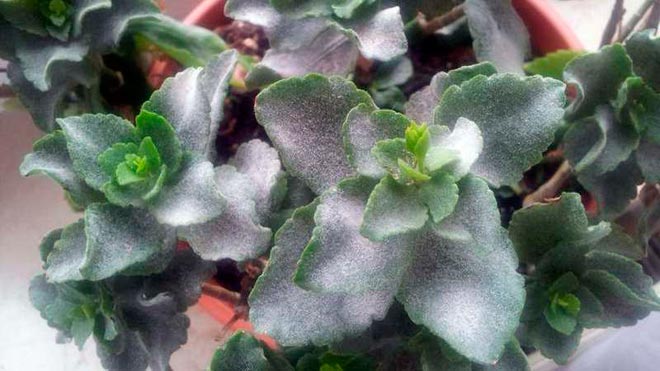

Home treatment consists of the use of fungicides designed to destroy the fungus on all parts of the plant:
- But;
- Tilith;
- Topsin;
- Fundazim;
- Speed;
- Fundazol;
- Bayleton;
- Quadris.
Also used are bio-fungicides containing live cultures of bacteria that suppress the reproduction of spores. Such preparations are safer from the ecological point of view, they can be used in the budding and flowering phase and at rest of the plant. But they are less effective and require repeated use.
Natural fungicidal preparations include the following:
- Planzir;
- Fitosporin-M;
- Pseudobacterin-2;
- Gamair.
You can fight powdery mildew with folk remedies:
- a mixture of soda ash and soap with soda, used for spraying;
- wood ash mixed with boiling water and grated laundry soap;
- fresh mullein and water;
- grass fermented in water;
- sour milk, kefir or yogurt.
A single spray is only used if a strong chemical fungicide is applied. The leaves and trunks of the Kalanchoe must be treated with natural remedies and organics until all the spores of the fungus are destroyed. This may require 2-3 or more treatments at intervals of 5-7 days.
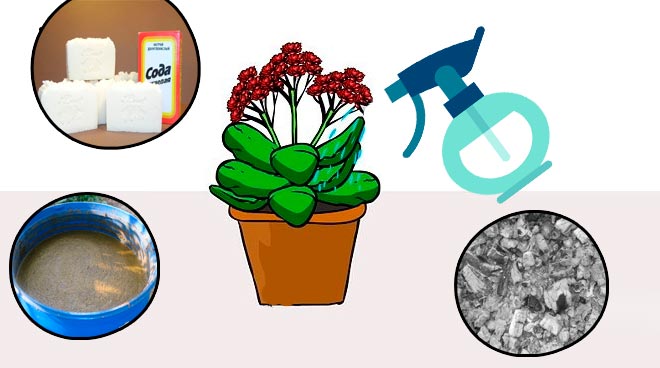

Mottling
There are several types of leaf spot:
- White. It manifests itself in small spots of a rounded brown shade. They grow over time. The central part is lighter, the edges become darker. At high humidity in the room, the spots rot, and at high temperatures, they dry out, forming holes on the surface of the leaves.
- Brown. It develops more often in late spring - early summer, manifests itself in spots of a light olive shade, barely noticeable.Over time, they turn yellow or turn brown, a grayish or brown coating with fungal spores forms on the underside of the foliage. Any wind or draft will carry these spores to other indoor plants. Spotting covers leaves, shoots, trunk, causing them to die off, disrupting photosynthesis, due to which the flower stagnates and does not bloom.
- Dry. It appears on the upper part of the leaves in dark spots of various shapes and sizes. Over time, the foliage falls off, turns yellow, in advanced cases, the spots can become black, rot forms under them. The causative agent is the spores of the fungus Alternaria solani, the second name of this disease is Alternaria. It develops at high humidity and temperatures above +26 C °. It is spread by mycelium, which is carried by air currents. Infection can occur through planting material or soil.
- Black bacterial... It manifests itself as spots on the leaves, the appearance of which is caused by the vital activity of bacteria. In general, this variety does not harm the plants, the greatest danger is falling foliage, but in any case it is necessary to fight. It develops under the influence of the microorganism Xanthomonas vesicatoria. It often affects immature flowers and planting material. Bacteria penetrate through microdamages on leaves and shoots, the optimal conditions for reproduction are high humidity and temperatures above +25 degrees.
- Fungal black. This type of spotting is caused by the spores of several types of fungi. The main symptom is dark brown spots on the leaves with a lighter center or border. The tissues swell. The disease covers shoots, stems, the plant weakens, leaf fall begins, budding is absent.
Natural wilting
Signs. The leaves sometimes turn yellow at the bottom of the stem, gradually dry up and fall off. The plant looks vigorous, grows well and blooms.
What to do. Don't change anything! Your pet is satisfied with absolutely everything. And the loss of some of the lower leaves is a normal natural aging process. You should not interfere with the usual microclimate. Kalanchoe feels great.
why do ficus leaves turn yellow and fall
Features of planting and transplanting a succulent
In most cases, modern indoor vegetation is introduced into a new home from a flower shop or garden center. And flower growers who have no experience believe that such a green pet does not need a transplant. However, during transportation and being on the counter, the plants are planted in an infertile substrate, which contains a minimum amount of nutrients. And if the flower is not transplanted from this meager soil mixture, it will begin to turn yellow after a short period of time due to a lack of trace elements.
It is recommended to wait 1-1.5 weeks, let the newly purchased plant adapt and start transplanting. If the time is tolerated and the planned event, then it is better to hold it in the spring. The procedure is performed according to the following algorithm:
- You should prepare a suitable potting mix, for example, by buying a ready-made one at a flower shop. It is best to choose soil for succulent plants. Or prepare it yourself by mixing in equal amounts leafy soil, sod and coarse sand.
- It is important to choose the right tank - do not take a too spacious container, it should be proportionate to the succulent. A layer of drainage material is placed at the bottom of the pot - expanded clay, vermiculite or brick chips. The container must have drainage holes to ensure the removal of excess moisture.
- 1/3 of the pot should be covered with soil and the plant should be carefully placed in it, straightening the roots.
- The remaining voids are covered with soil, the pot must be shaken periodically so that it settles. The soil should not be tamped, it should remain air and moisture permeable.
At the end of the procedure, Kalanchoe should be poured abundantly with warm, settled water.
Attention! The selection of a pot of the right size should be approached with all responsibility. In a cramped reservoir, a succulent will not be able to develop and grow properly, but in a large one there is a risk of soil acidification and subsequent decay of the rhizome.
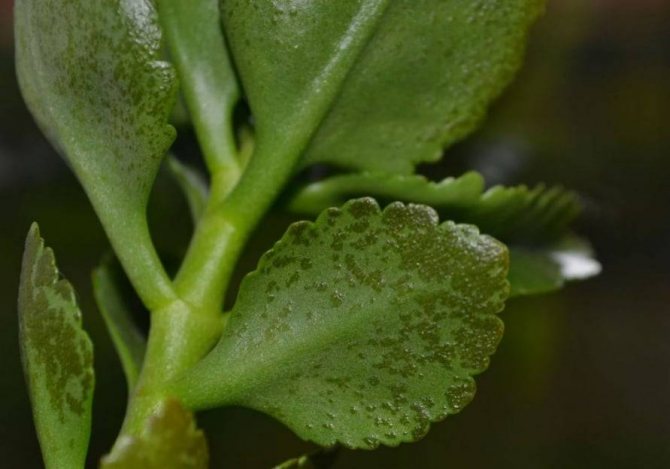

General information about the Kalanchoe plant
The Kalanchoe has green stems and leaves throughout the year, it blooms brightly and luxuriantly, and their attractive appearance decorates the house.


About 200 species of Kalanchoe are known, most of which are grown at home in indoor conditions.
The most popular species are pinnate single-flowered Kalanchoe:
- Blossfeld,
- Degremona.
Kalanchoe were originally inhabitants of the tropics, so almost all species can tolerate drought and also high humidity for a long time. It is also important that the Kalanchoe does not need fertilizers, they are resistant to diseases and pest attacks.
Photo
Leaf diseases and pests of Kalanchoe:
Bloom
The flowering period of decorative varieties sometimes lasts up to six months, but only if harmonious conditions are created. These are: balanced watering - on time and in the right amount - sufficient illumination without direct sunlight, recirculation of temperature and humidity.
The duration of flowering Kalanchoe depends on the conditions of detention
The bush will delight the eye of the florist if:
- it is planted by technology;
- the soil is correctly compiled;
- a suitable place was chosen, taking into account natural and additional lighting;
- spills in moderation, water for irrigation has a normal pH;
- gets all trace elements;
- extra shoots, old flowers and leaves are pinched off.
Heat
Signs. Leaves turn yellow throughout the plant, looking boiled, shriveled, but not dry. The plant as a whole looks healthy.
What to do. Stop frying Kalanchoe. It loves bright light, so many growers plant it on the south or west window. This is quite acceptable, but in recent years, the summer of the middle lane presents incredible surprises. In the sun, the thermometer creeps well above + 40 ° C. As a result, the plant is simply fried.
It is imperative to shade the Kalanchoe in the very sun. This can be done with white paper, light-weight thick cloth. As a result, the plant will receive enough light, but it will do without sunburn. Better yet, rearrange the pot behind the curtain. For example, on a table or bedside table near the window. Then you don't have to shade every day.
Flower care


It is worth noting that this flower does not belong to the picky ones, and talking about how to care for your home Kalanchoe, we will not open anything that a simple layman cannot do. The homeland of this plant is Madagascar, and it has a huge number of varieties. They differ greatly from each other in appearance, but the care requirements are mostly the same.
The first thing I want to talk about is watering. Given the homeland of the flower, we must understand that it does not like waterlogging. It must be watered with settled water at room temperature. When watering, it is very important not to fall on the leaves, but to direct the flow of water directly onto the ground. It is necessary to water so that the earth absorbs water and becomes moist, but so that there is no excess water left either in the pot or in the pan. In the case of the Kalanchoe, the principle “it is better to underfill than to overfill” applies. In summer and spring, the flower is watered more often, and in autumn and winter, watering should be reduced.
The next factor that is important is the degree of illumination. The fact is that Kalanchoe is a flower that needs to be “put to sleep”. And it's not a joke. From morning time until three in the afternoon, it is necessary to keep the flower pot in a well-lit place, for example, on a windowsill on the south side. But after this time, it must be rearranged into the shadow, to rest.If you cannot change the place, then just cover the flower with a handkerchief. If you do not do this, then the sun will spoil the leaves.
Requirements for the premises
Separately, it is worth talking about what temperature regime the Kalanchoe requires - a decorative flower. The ideal temperature for keeping it is considered to be about 18 degrees Celsius. But in the event of a decrease in the room, the plant will calmly transfer, if it is not higher than six degrees. However, if the temperature, on the contrary, increases, then this threatens problems, since the plant will begin to consume a lot of water, and this, in turn, entails rotting of the roots.
It is also important to monitor the humidity in the room. It has already been mentioned that the flower does not like waterlogging, which means that a dry climate must be maintained in the room. This is especially true in the autumn and winter periods, when there is high humidity outside.
What to do and how to treat the plant?
Yellow leaves are not a disease, but a symptom. This is a signal of the plant about improper care. No medication will help if watering, microclimate or feeding harm the flower. The owner's task is not to get rid of the visible manifestation, but to eliminate the cause.
A common cause of yellow foliage is improper care. The first step is to identify the florist in the cultivation. To cure a flower, you need to adjust the care.
From frequent watering, the plant's roots rot. To cure a flower, transplant it into a new container. When transplanting, clear the root of the earth. The putrefactive parts must be cut out. Treat the sections with crushed coal for disinfection.
Pests must first be removed from the leaves. For these purposes, a sponge moistened with soapy water is suitable. Treat a pure succulent with an insecticide. For Kalanchoe, "Inta-vir", "Karbofos" or "Metaphos" are suitable.
Important! Be sure to remove the affected parts of the Kalanchoe! Don't leave them on the stem.
By changing the approach to growing a succulent, you will improve its condition. In the future, if done correctly, this problem will not reoccur.
Preventive measures
In order for the Kalanchoe not to get sick and look healthy, it is necessary to adhere to the tips for caring for it and observe the conditions of detention, avoiding drafts, sudden temperature changes, overdrying the air or waterlogging the soil.
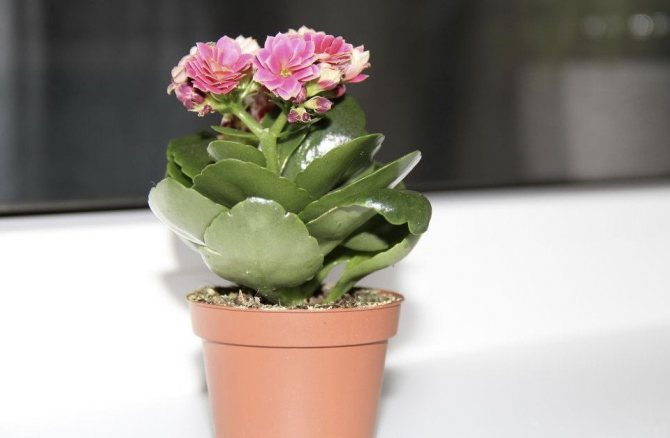

Basically, the prevention of yellowing of the leaves is as follows:
- Avoid exposure to sunlight. On sunny days, it is advisable to close the window with a curtain.
- Maintain the correct temperature. In summer - + 26 ... + 28 ° C, in winter - not lower than + 15 ° C.
- Ventilate the room. In this case, drafts should be avoided.
- Develop a watering schedule and adhere strictly to it. In winter it is more rare, in summer it is generous and frequent. Watering is carried out only with soft, settled water.
- Do not forget about feeding. Fertilizers are applied during the growing season in small doses. In winter, the flower is not fertilized.
- Formation of the bush. Pinch and trim the flower regularly to allow it to develop properly and not stretch out.
- Inspection for the presence of diseases and pests. The sooner the problem is noticed, the faster and easier it will be to get rid of it.
Did you know? In the late 60s, Kalanchoe was recognized as a medicinal plant and today it is recommended as an adjunct to the main course of treatment.
Thus, adherence to planting technology, proper care and competent feeding will help to avoid yellowing of the leaves of the plant and maintain its healthy appearance. And simple preventive measures, taken in a timely manner, will facilitate the cultivation of this flower.
Leaf propagation
The leaf propagation method can be used at any time of the year. You can cut off a fresh leaf and plant it in a prepared pot of soil. Cover the Kalanchoe with a glass container. In a few days, the rooting process takes place, and an independent plant is obtained.
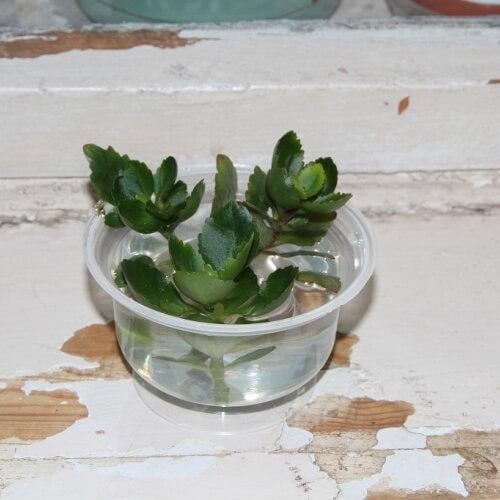

A new Kalanchoe can also be grown from a fallen leaf. To do this, take an old leaf, put it in the water for a while, until it sprouts. If you see that it is wasting away, starts to rot, then pinch off the spoiled piece. When the first roots appear, transplant into a pot. Read more about caring for and growing a plant in our article -
Transfer
Kalanchoe is transplanted as needed. The flower grows and develops quickly. To feel good, his roots need space: each new pot should be chosen 2 centimeters wider than the previous one. Then the root system will develop properly.
Change the pot to a larger one every year, preferably in the last days of March. This must be done with caution: the trunk, shoots and leaves of the plant are rather fragile. A lump of earth around the root system must be saved by adding some of the new earth. Use the same soil as when planting: the same amount of leaf, turf and sand. Drainage is required.
Love the flower, give it attention and care, devote some of your time and it will more than repay you. It will return goodness with its healthy appearance, healing properties or the beauty of inflorescences.
You can get acquainted with the reasons for the yellowing of Kalanchoe leaves and ways to help the plant from the proposed type of material. Happy viewing!
Kalanchoe leaves turn yellow: the main reasons
As a rule, the leaves of the succulent turn yellow as a result of irregularities in the care and maintenance of the succulent. The following factors can affect the state of the foliage of an indoor flower:
- improper planting of the plant;
- use of unsuitable or low-quality soil mixture;
- placing a flower in a place that does not suit it;
- violation of the temperature regime;
- excessively dry or humid indoor air;
- mistakes when watering a succulent;
- too scarce soil or an overabundance of minerals or organics in it;
- damage to the Kalanchoe by insect pests;
- the development of fungal or infectious diseases;
- natural aging processes.
And if the always vigorous, juicy succulent suddenly began to acquire a yellow color, first of all, you should find out why this is happening and only then take the necessary measures. Perhaps it will be enough to correct the grooming measures or change the conditions for keeping the flower. But, in some cases, you cannot do without the use of medications.
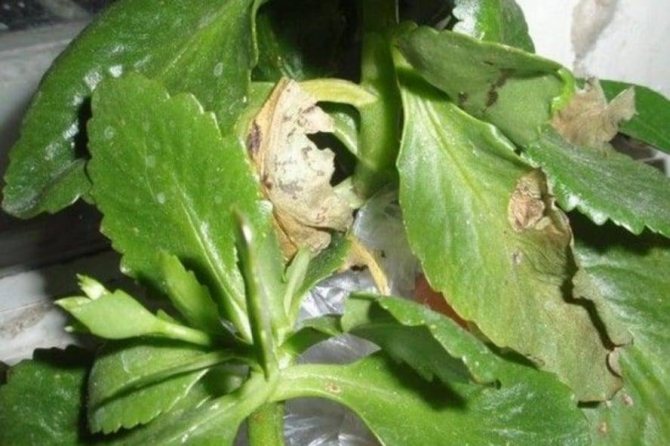

Propagation by cuttings
Another quick and unpretentious method of propagation is by cuttings. This will require a mature, large plant. Some of the Kalanchoe species recommend updating as follows: every time after it has given flowers. Based on this, you help to preserve the beautiful appearance of the plant.
For reproduction, it is necessary to choose a young shoot, of an even shape and with beautifully growing leaves. Since the further appearance of the Kalanchoe will depend on which stalk was rooted. It is recommended that the shoot be 5–8 cm long, if there is no cutting with this size, you can cut it off.
For the plant to take root, it must be cut along a diagonal line. Then they are planted in a pot. The ideal soil option is to mix peat with sand. After rooting, cut a little from all sides to form a beautiful bush.
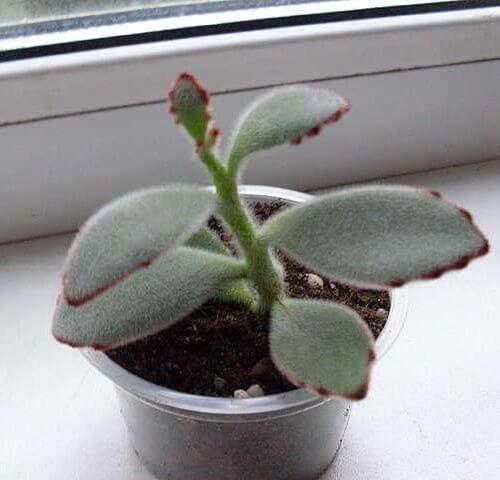

By the way! Read about the healing properties of Kalanchoe in our detailed article.
Common pests
- Aphid - the most dangerous enemy of the Kalanchoe. Appears mainly in spring. If you do not take action on time, it will spread to neighboring plants. Aphids are small green or black insects that appear on leaves or stems. She takes the sap of the plant and infects him with her poison. The damaged areas are covered with a sticky substance that prevents the plant from breathing.
At the initial stage, it is difficult to notice the infection, since the insects are very small and settle on the back of the leaf.It can only be detected due to the unhealthy appearance of the plant. It gets dirty and deformed. To get rid of aphids, you need to cut off the affected areas and burn them. Treat the remaining plant with an insecticide. Repeat once a week for a month. You can also use green potash soap: dilute in water and wash the plant with a solution. Can be replaced with laundry soap. Multi-claw mites - small glassy mites. When it appears, the leaves and petioles are covered with a brown scab, the tissues of the plant harden and bend. Wash the insects off with soapy water and treat the plant with insecticide.
Shields and false shields - insects with a two-millimeter body covered with wax on top. They form a plaque (in which a sooty fungus is formed) and an accumulation of insects on the plant. Leaves turn yellow, fall off, growth slows down, flowering stops. For treatment, immediately remove all insects and wash the plant with soapy water. Treat insects with alcohol before removing insects. You can use folk remedies (wipe the plant with a cotton swab with alcohol, use garlic or an old toothbrush).
- Mealybug - the insect feeds on Kalanchoe juice. It multiplies the black mold fungus. If you do not take action, the plant will die. The appearance is determined by the appearance of a white waxy discharge. For treatment, use a mineral oil spray on the leaves.
And so leaf diseases and flower pests look in the photo.
Conditions for growing succulents
In general, all plants capable of storing moisture and successfully tolerating even long dry periods require special conditions for keeping. This also applies to Kalanchoe, he is able to do without water, but its excess is dangerous for him. And also, succulent vegetation requires a certain temperature, humidity and lighting. Due to violations of the maintenance, the Kalanchoe turns yellow, the foliage withers and the general condition can seriously worsen.
Lighting
Most preferred for this plant is 10 hours of daylight. The abundance of light allows it to maintain a rich green color and look blooming.
The most successful place for Kalanchoe is the window sills located on the southwest or southeast side. If the pot is on the south window, then during the summer heat it is better to shade the flower, as burns may remain on its leaves.
In autumn and winter, in regions where daylight hours become very short, it is worth taking care of additional lighting for this plant. You can install a fluorescent or phytolamp.
It is important! It is recommended that some decorative varieties be artificially deprived of light in winter, reducing the duration of daylight hours to 8 hours, and after this time, cover the succulent pot with a paper bag or box. This measure stimulates the flowering process. But, this method does not apply to all varieties of Kalanchoe.
The location of the container with the plant on the north side can negatively affect its appearance. With a lack of lighting, the stems and shoots of the flower begin to stretch out, bend, the leaf plates become thin, their color fades noticeably.
With a lack of sunlight in Kalanchoe, the upper leaves turn yellow, and with an excess of foliage, it evenly acquires a yellow or reddish tint.
Temperature regime
The optimal indicator for the spring-summer period is +20 - +26 degrees. In winter, it is recommended to lower the temperature to +15 degrees, in such conditions the plant fully rests. In summer, an increase in the thermometer up to +30 degrees is permissible.
Experienced succulent breeders advise against placing a flower pot next to a working heating device.They not only significantly increase the temperature of the air, but also make it too dry, which negatively affects the condition of the leaves.
But sharp temperature changes are also dangerous for this plant, when heat blows from batteries and heaters, and frosty air comes from the window. That is why, with the beginning of the heating season, many Kalanchoe leaves turn yellow and dry. To remedy the situation, it is recommended to move the flower away from artificial heat sources.
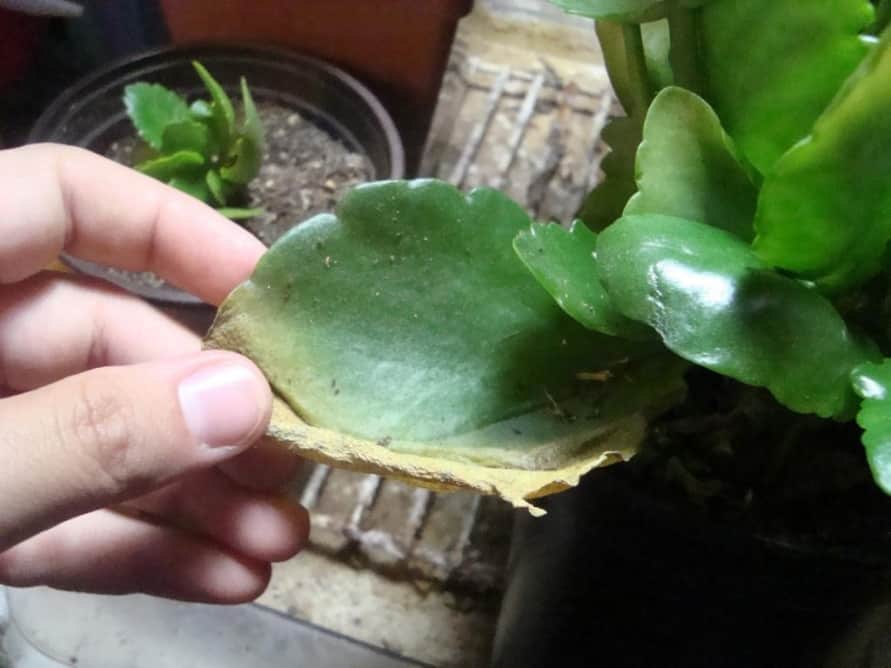

Watering rules
As practice shows, succulents most often fall ill and die as a result of excessive moisture intake and Kalanchoe is no exception. You can avoid such fatal mistakes by adhering to the advice of experienced succulent growers:
- for irrigation of such vegetation, only settled water is used, the temperature of which should be room temperature or a couple of degrees warmer;
- abundant watering is carried out only in summer;
- from autumn, the number of waterings is reduced and the intervals between procedures are maximized in winter; wintering in the cool Kalanchoe is rather poorly watered once a month.
In the heat, the flower can be irrigated from a spray bottle, but it is enough to do this once every 7–9 days, using boiled or purified water, so that no limescale remains on the surface of the leaves.
The foliage of a succulent may turn yellow when watering it with tap water. Without settling, chlorine is retained in it, which not only harms the flowers, but can also lead to their death.
Attention! If the soil in the pot is covered with a whitish or yellowish coating, then the flower is watered with hard tap water. This does not seriously harm the succulent, but deprives the plant of its aesthetic appearance. In this case, it is recommended to remove the topsoil and replace it with a fresh one.
In spring and summer, it is enough to water Kalanchoe once a week, and in winter - 2-3 times a month. In winter, you can navigate by the state of the soil, if the earthy clod is dry, then it's time to moisten it.
If the foliage of a green pet turns yellow, and the tips of the leaves are dry, then perhaps it does not have enough moisture. In this case, the number of waterings should be increased.
But, when his leaves not only turn yellow, but also wither, then most likely we are talking about the overflow of the soil. This is a very dangerous condition that requires mandatory drying of the soil and a reduction in irrigation.
It is important! If the plant for some reason has suffered a prolonged drought, then watering should be started very carefully, little by little, gradually accustoming the succulent to moisture. The amount of water should be gradually increased each time until its volume reaches the usual rate.
Succulent feeding
As it turned out, the Kalanchoe foliage can turn yellow and fall off due to frequent fertilization or non-compliance with the dosage. This leads to an excess of mineral salts in the soil.
It is enough to fertilize this succulent once every 4–5 weeks, when the plant is actively growing and developing - from the beginning of spring to the end of October. In winter, it is at rest, so it does not need additional nutrition to stimulate growth. If you force the flower to grow by applying top dressing, then its shoots will begin to stretch intensively, bend, and the foliage will acquire a yellow tint.
Non-flowering varieties can be fertilized with formulations intended for succulent or decorative deciduous vegetation. Blossfeld's luxuriously blooming Kalanchoe Kalanchoe is recommended to be fed when its buds are laid, using complex mixtures or preparations for flowering plants.
Natural aging
Do not forget that plants are also prone to aging, in which case their foliage turns yellow and falls off for quite natural reasons. If the owner wants to preserve the succulent plant, then it is worth doing grafting. For this, the apical or lateral shoots are taken.


Very low air humidity
Kalanchoe is adapted to the existence of low humidity. However, very dry air can greatly harm the plant. This is especially dangerous in combination with the high temperature of the content. In such conditions, the leaves turn yellow and dry, and then crumble.
Most often, plants suffer from dry air during the heating season.... With proper maintenance in winter, the air temperature for Kalanchoe should be reduced to 15-17 ° C.
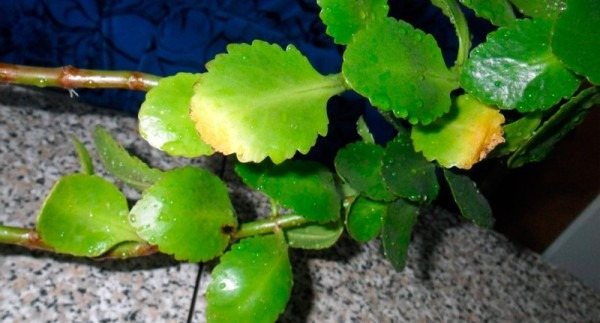

But if this is not possible and the plant is kept at room temperature, and even near a heating radiator, it can lose most of its leaves, especially from the side of the heating device. To prevent this from happening, in winter you need to keep the flower on the coldest windowsill away from heating.

